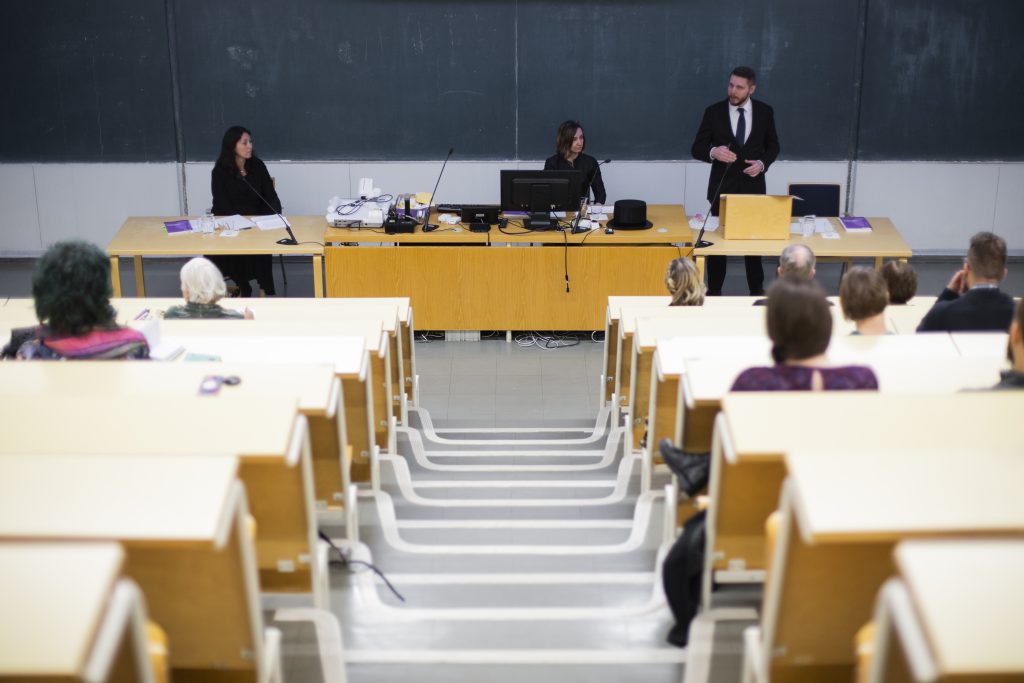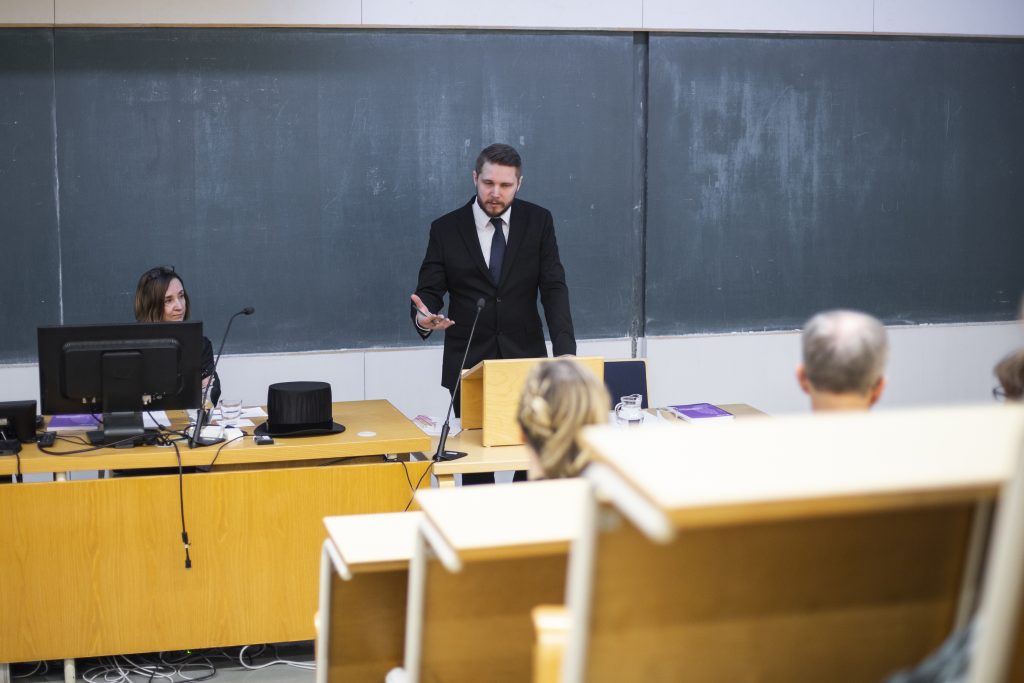FM Tuomas Äystön uskontotieteen alaan kuuluva väitöskirja ”Religious Insult as a Societal Concern in the 21st Century Finland” tarkastettiin Turun yliopistossa lauantaina 26.10.2019. Vastaväittäjänä toimi professori Lene Kühle (Aarhusin yliopisto, Tanska) ja kustoksena professori Terhi Utriainen (Turun yliopisto). Väitöskirja on luettavissa osoitteessa http://urn.fi/URN:ISBN:978-951-29-7807-6
If I were to hand out pieces of paper and ask you, the members of the audience: “please, define religion”, what would we find? I claim most of you would list roughly the same things. Perhaps something to do with belief in God, buildings like churches or mosques, sacred symbols, praying, traditional practices within communities, and so forth. Examples like Christianity, Islam and Judaism come to mind, when one mentions the word “religion”.
Indeed, if you didn’t list roughly the same things when defining such an everyday concept, communication itself would be cumbersome. If we all didn’t know pretty well what religion is, simple things like sections of a books store, newspaper headlines or Finnish school curriculum wouldn’t make much sense. If someone tells you that this space is a space for religious worship and thus sacred, chances are, that you will act accordingly, that is, with proper respect towards the sacred.
Why make these points? The fact that the concept of religion appears to have a self-evident meaning according to our commonsense, does not mean that it actually has a self-evident meaning: on the contrary. A central claim of discourse theory is, that our commonsense knowledge itself is something that is shaped over time. What appears to be commonsense is, in reality, a result of a historical process, riddled with political conflicts, which are likely ongoing. Where there is conflict, there are questions of power. For example, who has the power to define religion? Furthermore, if our history of power struggles had turned out differently, our commonsense, too, would be different.
Our history is quite Lutheran. Kingdom of Sweden became Lutheran in the 16th century, and when the area of Finland was later part of the Russian empire, the Tsar allowed it to remain as Lutheran. The constitution of Finland, enacted in 1919 and the Freedom of Religion Act of 1923 granted the freedom of religion, including the right to revoke ones’ membership from the Lutheran Church. At the time, many Finns feared, that the leftists who often mounted harsh criticism against the church would leave in big numbers. However, this did not happen. Perhaps they underestimated just how Lutheran we were. Large scale disaffiliation from the Lutheran church as a political act is a phenomenon of a much more secularized era, namely that of 21st century.

We also have another legacy from the Kingdom of Sweden: blasphemy. A simple definition of blasphemy is, that it is speaking ill of God. A societal reaction towards a defamation of the sacred is in itself a common human phenomenon. Blasphemy criminalization is merely a version of this reaction, coded in form of law.
What blasphemy means, however, depends on the time and place. During the premodern times, blasphemy was, more than anything, a societal crime, a crime against the social order. The social order, led by the king and church, was ultimately legitimated by God, and thus, attacks on God meant attacks on king and the church as well. That is to say, attacks against the society. Interestingly, a blasphemy conviction could also be passed due to improper public behavior such as drinking or vagrancy.
Blasphemy tends also to be political, precisely because it was so powerful and societal symbolic transgression. For example, a premodern nobleman could use blasphemy as a boast, demonstrating that he feared neither king nor the church. If we move forward in time, all the way to the edge of the Finnish independence from the Russian Empire, we find that blasphemy became a tool of the political left. At the beginning of the 20th century, the number of blasphemy convictions in the Grand Dutchy of Finland was in the hundreds. Many of those convicted were freethinkers or socialists, who attacked the Lutheran church or the prevailing Christian morality.
This leftist bend of blasphemy was still visible in the late 1960s, now in the independent Finland, when the most famous blasphemy cases of our legal history – those involving the writer Hannu Salama and the artist Harro Koskinen – were underway.
However, the politics of transgression change, yet again, as we approach the current era. In the 1960s, the political left represented a counterculture against the consensual Christian morality, exemplified by the mentioned leftist cultural figures Salama and Koskinen. Moving forward, in the 1980s and the early 1990s, the notion “political incorrectness” still meant criticism of the elites or those with power; for example, the Finnish politicians or the Soviet Union.
However, today the political situation is, in this respect, almost the opposite. Now the far right has claimed both the subversive and transgressive politics. Today, “political incorrectness” is oftentimes merely a euphemism for attacks on various minorities.
Relatedly, modern blasphemy, or rather, religious insult cases – as they are often called today – mostly concern attacks on minority groups. Informed by the understanding of the international law, according to which minority groups are particularly vulnerable, the Finnish legal officials go about handling cases, which mostly deal with Islam. And, several of these cases involve politicians or candidates who wish to make use of the publicity and claim the cause of the freedom of speech.
My modest contribution in this doctoral dissertation is an analysis of the materials related to the current Finnish law on breach of the sanctity of religion. That is to say, I have investigated what the Finnish politicians and officials of the 21st century actually do, when they talk about or apply this law. What are they actually protecting? How do they understand the sacred and the religion, they protect?
It turns out that it matters how these concepts are understood. Modern people tend to view the society as naturally divided into spheres, such as politics, science, religion, journalism, economy, and so on. Modern people also like to think that bulk of these spheres are best kept separate. For example, if a politician uses overtly religious language in the parliament or in media, or if a scientist presents religious theses, this often makes the modern observer suspicious.
However, in order to keep religion sufficiently separate from politics, journalism or science, we must, of course know what is meant by religion. This demarcation is arbitrary and historical, not natural. For example, in politics, we would likely deem a Biblical sermon in the parliament floor as problematic, but the annual church service held at the beginning of each parliamentary term, much less so.
In the context of my research, the understanding of religion stems formally from the Freedom of Religion Act, which defines “church” and “registered religious community”. These are the groups, which the religious insult law officially protects.

Legal devices and concepts are designed to be specific, and this is a good thing. We would like to have judges that pass predictable verdicts, in which concepts like religion and sacred are understood and applied in a uniform way. The problem is, that reality is a mess, and the human reality particularly so. You can experiment this yourself: pick anything and try to define it really well. As you think about your definition more and more, you will likely find problem after problem. You will find, that too few or two many things fit your definition.
In Finland, the people who go about mocking religious sacred things, rarely mirror the structure of the categories of “church” and “registered religious community”, as presented in the law. Instead, the defendants talk about general groupings like Christianity, Islam or Judaism. That is to say, the defendants rarely attack concrete legal entities, but they attack much more general and popular abstractions.
When the prosecutors and judges face this messy reality, they find that the legal devices for religion only take them so far. The officials now have to consider what is sacred in Christianity in general, or in Islam in General. You can, again, perform a thought experiment. Can you provide an elaborate answer to the question, what is sacred in Buddhism?
For this challenge, the legal sources provide no direct help at all. Thus, this is where the popular, prevalent or lay understanding of religion enters the legal language. Indeed, I make the argument, that the understanding of religion among the politicians, the Prosecutor General and the judges, resembles the popular understanding of religion, as found, for example, in the mass media.
It turns out, that one of the crucial features of the sacred is, that it is known and talked about – insofar the legal outcomes are concerned.
Why this matters? As described earlier, our commonsense is historical, and this is the thought I’d like to leave you with. What we, as a linguistic community – and consequently, the Finnish politicians and officials – find obviously religious and obviously sacred within religions, does not include everyone, and everything. For example, groups, which identify as religious, or wish to make use of the legal framework due to some other reason, but who do not fit our commonsense template of religion, will need to work much harder in order to benefit from the various religion related legal devices we have.